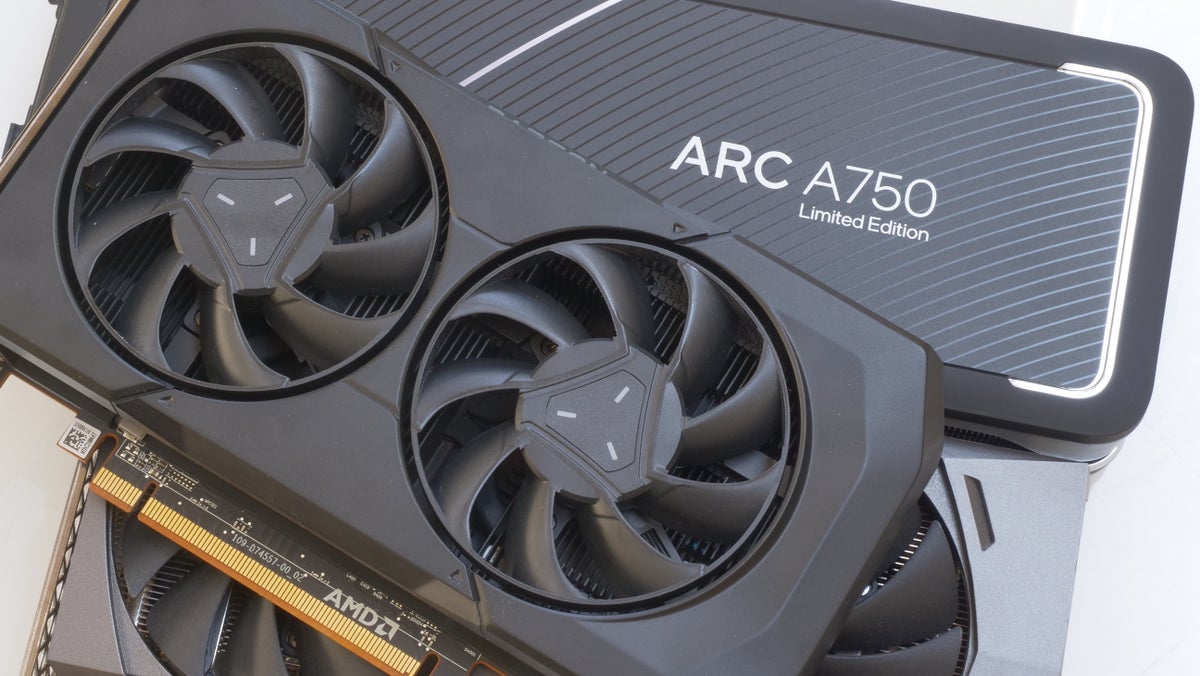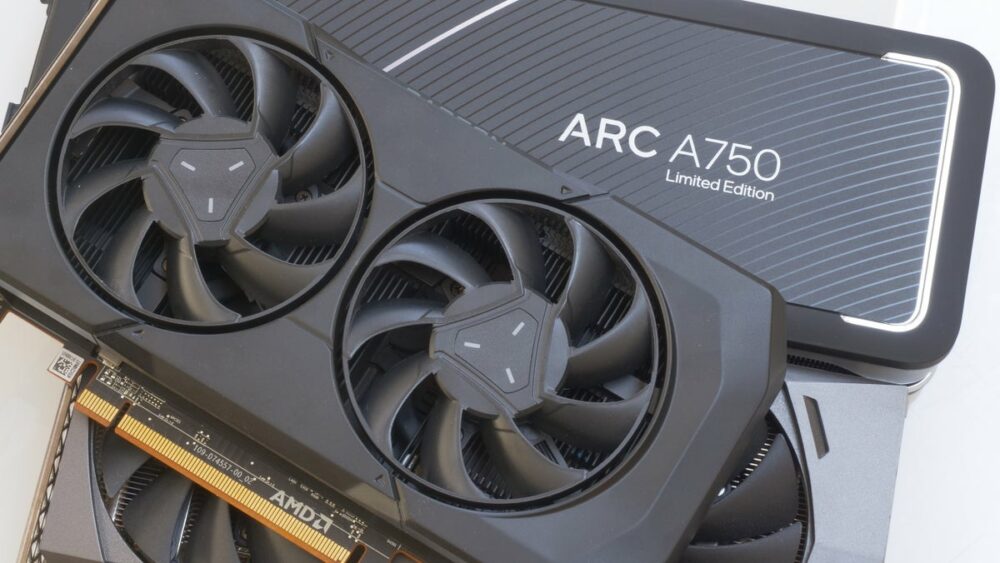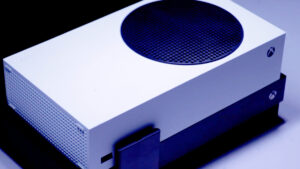
Nvidia’s RTX 4060 is coming at the end of the month – and as a result, it seems that price-cutting in the entry level graphics card market is absolute carnage at the moment, to the point where we’ve even seen the potent RTX 3060 Ti available at sub-£300 prices. Meanwhile, the RTX 3060 – the world’s most popular GPU, according to the Steam Hardware Survey – is now available for well under £300/$300, pricing on Intel’s Arc A750 can deliver some preposterously good value, while last-gen AMD RDNA 2 cards are so cheap, it’s causing problems for the new RDNA 3-powered RX 7600.
So, initially, this piece was planned as a review for the RX 7600, but the more I looked at the surrounding GPUs in the market and the more I saw the extent of the price-cutting involved, the more I realised that this topic is exceptionally complex. The Radeon RX 7600 hasn’t been reviewed well, but it’s actually a very sound piece of hardware. The problem is that massive price-cuts on older cards are making its value proposition look less than compelling – and I’m going to be curious to see if this also has an impact on the upcoming RTX 4060, bearing in mind that its own gen-on-gen performance increases look relatively modest.
In addition to the price-cutting, another story started to emerge as the benchmark results coalesced. Intel’s Arc A750 and A770 are actually exceptionally good products when tasked with running modern games – and some of Intel’s own (limited time) price cuts translate into exceptional value. The retail price of the Arc A750 is £230/$250 – and yet as you’ll see on the following pages, the price vs performance ratio (particularly in RT heavy games) is off the charts, to the point where the RTX 4060 Ti looks severely over-priced. So, as well as being a look at a highly volative graphics marketplace, this article also serves as a re-examination of Intel Arc.
There’s a wealth of data across the following pages, but it may well be the case that some of nuance is lost amongst the numbers, so please do consider watching the video above where I attempt to thread the needle through a patchwork of competing factors when considering a new GPU purchase at the lower end of the graphics market. However, one thing I’d like to stress is that it’s actually difficult to find a ‘slam dunk’ definitive purchase that’s leagues ahead of the others. What you do get is a range of choice across a wealth of relatively powerful cards.
And remember, while we’re talking about the concept of a ‘1080p GPU’, what we’re talking about is max preset 1080p, meaning that optimised settings makes 1440p viable too. The provision of upscaling – especially effective with the hardware accelerated options of DLSS and XeSS – means that even an RTX 3060 12GB can deliver a 4K 60fps experience with tweaked settings too. DLSS performance mode looks the part and the performance is undeniable.
I think my overall takeaway is that there are great recommendations from all three vendors, prices are remarkably good (and may get even lower once the RTX 4060 actually launches), so I’ve tried to offer up my various recommendations at the end of the article, skewed towards what your priorities might be, whether it’s straight rasterisation performance, RT or upscaling. However, it would make sense to wait and see what Nvidia has for us with the RTX 4060 – unless its 8GB of framebuffer memory is a instant dealbreaker for you.
And with that said, let’s move onto the range of benchmarks we’ve put together. Primarily, this is the groundwork for the RTX 4060 review to come (where we’ll be adding further cards including the likes of the RTX 2060 and GTX 1060) so it’s based around our usual test station, based on an Intel Core i9 13900K on stock settings, running on an Asus Maximus Hero Z690 board, paired with two 16GB modules of GSkill 6000MT/s memory.
The 1080p GPU Shoot-Out
- Introduction [This Page]
- RT benchmarks: Dying Light 2, Cyberpunk 2077, Control
- RT benchmarks: Hitman 3, Metro Exodus Enhanced Edition, F1 22
- RT/DLSS/FSR2/DLSS3 benchmarks: Cyberpunk 2077, Dying Light 2, Forza Horizon 5
- Game benchmarks: Control, Cyberpunk 2077, F1 22, Forza Horizon 5
- Game benchmarks: Hitman 3, A Plague Tale: Requiem, Returnal
- Conclusions and recommendations
- SEO Powered Content & PR Distribution. Get Amplified Today.
- EVM Finance. Unified Interface for Decentralized Finance. Access Here.
- Quantum Media Group. IR/PR Amplified. Access Here.
- PlatoAiStream. Web3 Data Intelligence. Knowledge Amplified. Access Here.
- Source: https://www.eurogamer.net/digitalfoundry-2023-amd-radeon-rx-7600-vs-nvidia-rtx-3060-vs-arc-a750
- 22
- 4k
- a
- A Plague Tale: Requiem
- About
- above
- Absolute
- accelerated
- according
- across
- actually
- adding
- ADDITION
- ahead
- All
- also
- AMD
- amongst
- an
- and
- ARE
- around
- article
- as
- Asus
- At
- available
- based
- BE
- been
- being
- Benchmark
- benchmarks
- BEST
- board
- but
- CAN
- card
- Cards
- case
- causing
- Charts
- Cheap
- choice
- come
- coming
- compelling
- competing
- complex
- complicated
- concept
- Consider
- considering
- content
- Control
- cookie
- cookies
- Core
- Curious
- Cyberpunk
- Cyberpunk 2077
- data
- Deals
- deliver
- delivering
- difficult
- discovered
- DLSS
- do
- Dying Light 2
- edition
- Effective
- emerge
- enable
- end
- enhanced
- entry
- especially
- Eurogamer
- even
- exceptional
- Exodus
- experience
- F1
- F1 22
- Factors
- find
- Following
- For
- Forza
- Forza Horizon
- from
- further
- Games
- Get
- going
- good
- GPU
- graphics
- great
- Hardware
- has
- heavy
- Hero
- highly
- hitman 3
- horizon
- however
- HTTPS
- i
- if
- Impact
- in
- Including
- increases
- initially
- instant
- Intel
- into
- involved
- Is
- IT
- ITS
- jpg
- launches
- leagues
- less
- Level
- light
- like
- Limited
- ll
- Look
- looked
- looks
- lost
- make
- MAKES
- Making
- manage
- mark
- Market
- marketplace
- massive
- May
- meaning
- means
- Meanwhile
- memory
- Message
- Metro
- might
- mind
- mode
- Modern
- modest
- modules
- moment
- Month
- more
- most
- Most Popular
- move
- my
- New
- now
- numbers
- nvidia
- of
- off
- offer
- on
- once
- One
- Options
- or
- Others
- our
- overall
- own
- page
- part
- particularly
- performance
- piece
- Plague
- planned
- plato
- plato data intelligence
- platodata
- platogaming
- please
- Point
- Popular
- powerful
- price
- prices
- pricing
- primarily
- Problem
- problems
- Products
- provision
- purchase
- put
- range
- ratio
- RE
- recommendations
- relatively
- remarkable
- Remember
- result
- Results
- retail
- review
- rich
- rt
- running
- RX
- s
- Said
- saw
- see
- seems
- seen
- sense
- serves
- severely
- So
- some
- sound
- started
- station
- Steam
- stock
- Story
- straight
- stress
- surrounding
- Survey
- Takeaway
- tale
- talking
- targeting
- test
- than
- that
- The
- the world
- there
- thing
- think
- this
- three
- Through
- time
- to
- together
- too
- topic
- towards
- tried
- two
- under
- up
- upcoming
- upscaling
- us
- value
- various
- ve
- vendors
- very
- Video
- vs
- wait
- was
- watching
- we
- Wealth
- well
- What
- when
- where
- whether
- while
- with
- world
- would
- yet
- you
- your
- zephyrnet












